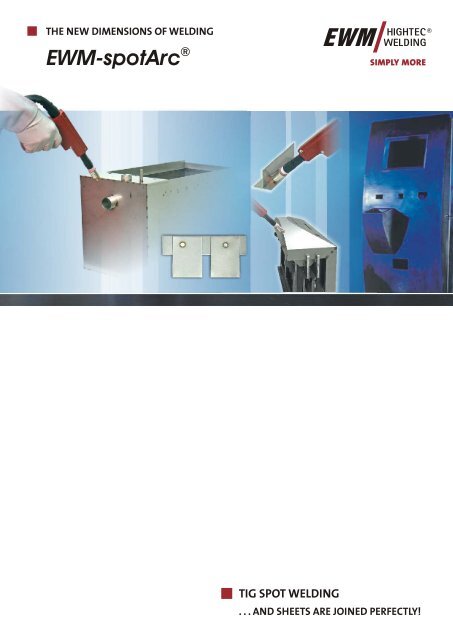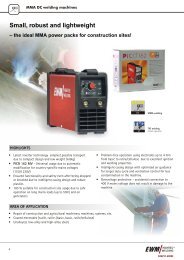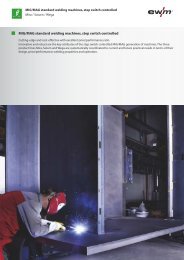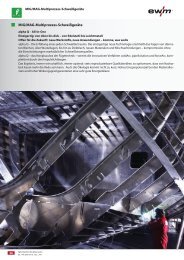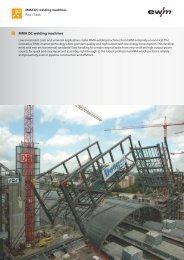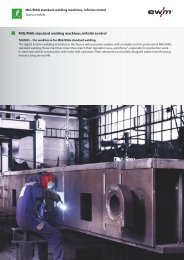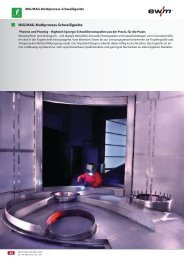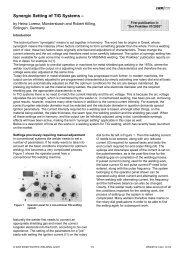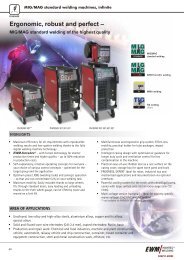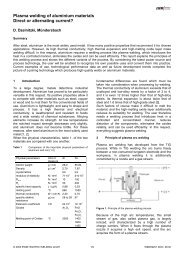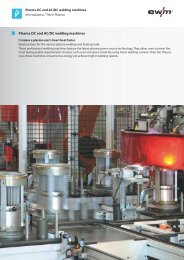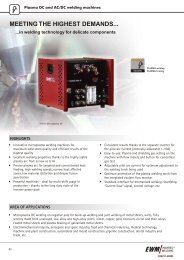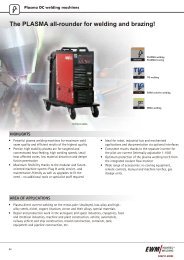Product information spotArc - Ewm-sales.co.uk
Product information spotArc - Ewm-sales.co.uk
Product information spotArc - Ewm-sales.co.uk
Create successful ePaper yourself
Turn your PDF publications into a flip-book with our unique Google optimized e-Paper software.
THE NEW DIMENSIONS OF WELDING<br />
EWM-<strong>spotArc</strong> ®<br />
TIG SPOT WELDING<br />
. . . AND SHEETS ARE JOINED PERFECTLY!
HIGHLIGHTS<br />
• Universal applications thanks to the option of<br />
<strong>co</strong>nnecting multiple metal sheets, including metal<br />
sheets of different thicknesses<br />
• Simple to use - welding only carried out on one<br />
side<br />
• E<strong>co</strong>nomic solution <strong>co</strong>nsisting of standard<br />
<strong>co</strong>mponents:<br />
EWM TIG welding machine, TIG spot welding<br />
torch and optional spot remote <strong>co</strong>ntrol<br />
• Machine can also be used for TIG and MMA seam<br />
welding<br />
in addition to spot welding!<br />
• Ergonomic torch design for the best possible<br />
handling and optimum power utilisation<br />
©2008 EWM HIGHTEC WELDING GmbH GB_EWM-<strong>spotArc</strong> 1 09.2008
Benefits of EWM <strong>spotArc</strong> TIG spot welding<br />
Surface formation in<br />
TIG spot welding<br />
• Better surface formation in <strong>co</strong>mparison to<br />
resistance welding<br />
• Flatter spot formation in <strong>co</strong>mparison to<br />
MAG spot welding<br />
• Excellent seam quality thanks to<br />
the minimal heat feeding<br />
• Very low thermal tensions and<br />
little distortion thanks to short welding times<br />
• Ideal for visible joins<br />
thanks to the clean seam finish<br />
©2008 EWM HIGHTEC WELDING GmbH GB_EWM-<strong>spotArc</strong> 2 09.2008
Applications<br />
• Spot welding of low-alloy and high-alloy sheet steel up to 2.5mm<br />
• Multiple metal sheet <strong>co</strong>nnections, spot joins on visible metal sheets, tack welding<br />
• Container <strong>co</strong>nstruction, switching cabinet <strong>co</strong>nstruction, machine and vehicle manufacturing, car and<br />
food industry<br />
©2008 EWM HIGHTEC WELDING GmbH GB_EWM-<strong>spotArc</strong> 3 09.2008
The <strong>co</strong>rrect nozzle shape for every join<br />
Butt joint/lap joint T-joint<br />
Corner joint Butt joint<br />
DN (Ø<br />
mm)<br />
25<br />
50<br />
65<br />
80<br />
100<br />
butt weld fillet weld <strong>co</strong>rner joint butt joint<br />
©2008 EWM HIGHTEC WELDING GmbH GB_EWM-<strong>spotArc</strong> 4 09.2008
Frequently used spot weld types<br />
EWM-<strong>spotArc</strong><br />
Arc spot welding<br />
Resistance spot welding<br />
enclosed<br />
sections<br />
not<br />
possible<br />
metal sheets<br />
Two-sided<br />
One-sided<br />
metal sheets<br />
©2008 EWM HIGHTEC WELDING GmbH GB_EWM-<strong>spotArc</strong> 5 09.2008
System overview<br />
CLASSIC-<strong>co</strong>ntrol<br />
RTP3 required<br />
by kHz pulsed<br />
RTP 3<br />
DC-Welding equipment:<br />
PICOTIG 220; TRITON 220, 260,400, 500;<br />
and all TETRIX<br />
RTP 3<br />
©2008 EWM HIGHTEC WELDING GmbH GB_EWM-<strong>spotArc</strong> 6 09.2008
Basic settings for RTP 3<br />
CrNi<br />
Seam type<br />
butt joint<br />
lap joint<br />
fillet weld<br />
spots<br />
Carbon-steel<br />
Sheet thickness<br />
1 mm/1 mm<br />
2 mm/2 mm<br />
1 mm/2 mm<br />
1 mm/1 mm<br />
1 mm/1 mm<br />
2 mm/2 mm<br />
1 mm/1 mm<br />
2 mm/2 mm<br />
Frequency Spot time Current Down slope<br />
2,5 khz 0,25 sec 70 A 0,9 sec<br />
2,5 khz 0,25 sec 130 A 0,9 sec<br />
2,5 khz 0,25 sec 260 A 0,9 sec<br />
2,5 khz 0,25 sec 320 A 0,9 sec<br />
2,5 khz 0,25 sec 70 A 0,9 sec<br />
2,5 khz 0,25 sec 130 A 0,9 sec<br />
2,5 khz 0,25 sec 120 A 0,9 sec<br />
2,5 khz 0,25 sec 170 A 0,9 sec<br />
For all parameters the pulse wave duty cycle is 50:50<br />
Seam type<br />
Sheet thickness<br />
Frequency<br />
Spot time<br />
Current<br />
Down slope<br />
butt joint<br />
1 mm/1 mm<br />
2,5 khz<br />
0,25 sec<br />
80 A<br />
0,9 sec<br />
2 mm/2 mm<br />
2,5 khz<br />
0,25 sec<br />
150 A<br />
0,9 sec<br />
lap joint<br />
2 mm/2 mm<br />
2,5 khz<br />
0,25 sec<br />
276 A<br />
0,9 sec<br />
fillet weld<br />
1 mm/1 mm<br />
2,5 khz<br />
0,25 sec<br />
70 A<br />
0,9 sec<br />
For all parameters the pulse wave duty cycle is 50:50<br />
©2008 EWM HIGHTEC WELDING GmbH GB_EWM-<strong>spotArc</strong> 7 09.2008
System overview<br />
COMFORT-<strong>co</strong>ntrol<br />
DC-Welding equipment:<br />
PICOTIG 220; TRITON 220, 260,400, 500;<br />
and all TETRIX<br />
©2008 EWM HIGHTEC WELDING GmbH GB_EWM-<strong>spotArc</strong> 8 09.2008
System overview<br />
SYNERGIC-<strong>co</strong>ntrol<br />
DC-Welding equipment:<br />
PICOTIG 220; TRITON 220, 260,400, 500;<br />
and all TETRIX<br />
©2008 EWM HIGHTEC WELDING GmbH GB_EWM-<strong>spotArc</strong> 9 09.2008
TETRIX COMFORT- and SYNERGIC <strong>co</strong>ntrol<br />
Carbon-steel<br />
Seam type<br />
Sheet thickness<br />
Frequency<br />
Spot time<br />
Current<br />
Down slope<br />
butt joint<br />
1 mm/1 mm<br />
automatic<br />
0,3 sec<br />
165 A<br />
0,5 sec<br />
2 mm/2 mm<br />
automatic<br />
0,35 sec<br />
245 A<br />
0,5 sec<br />
lap joint<br />
1 mm/1 mm<br />
2,5 khz<br />
with out activArc<br />
0,3 sec<br />
250 A<br />
0,5 sec<br />
2 mm/2 mm<br />
2,5 khz<br />
with activArc<br />
0,5 sec<br />
270 A<br />
0,5 sec<br />
fillet weld<br />
1 mm/1 mm<br />
automatic<br />
with activArc<br />
0,5 sec<br />
170 A<br />
0,5 sec<br />
2 mm/2 mm<br />
2,5 khz<br />
with activArc<br />
0,45 sec<br />
270 A<br />
0,5 sec<br />
©2008 EWM HIGHTEC WELDING GmbH GB_EWM-<strong>spotArc</strong> 10 09.2008
TETRIX COMFORT- and SYNERGIC <strong>co</strong>ntrol<br />
CrNi<br />
Seam type<br />
Sheet thickness<br />
Frequency<br />
Spot time<br />
Current<br />
Down slope<br />
butt joint<br />
1 mm/1 mm<br />
automatic<br />
0,3 sec<br />
100 A<br />
0,5 sec<br />
1 mm/1 mm<br />
2,5 khz<br />
with out activArc<br />
0,3 sec<br />
100 A<br />
0,5 sec<br />
2 mm/2 mm<br />
2,5 khz<br />
with activArc<br />
0,35 sec<br />
180 A<br />
0,7 sec<br />
lap joint<br />
1 mm/1 mm<br />
automatic<br />
with activArc<br />
0,4 sec<br />
200 A<br />
0,1 sec<br />
1 mm/1 mm<br />
2,5 khz<br />
with out activArc<br />
0,4 sec<br />
200 A<br />
0,1 sec<br />
2 mm/2 mm<br />
2,5 khz<br />
with activArc<br />
0,5 sec<br />
270 A<br />
0,5 sec<br />
fillet weld<br />
1 mm/1 mm<br />
automatic<br />
with activArc<br />
0,5 sec<br />
150 A<br />
0,1 sec<br />
2 mm/2 mm<br />
2,5 khz<br />
with activArc<br />
0,5 sec<br />
250 A<br />
0,3 sec<br />
©2008 EWM HIGHTEC WELDING GmbH GB_EWM-<strong>spotArc</strong> 11 09.2008
Spot technology, fast, low-voltage –<br />
Spot welding with tungsten shielding gas<br />
by Heinz Lorenz, Mündersbach, Germany<br />
Introduction<br />
In mechanical engineering, switch cabinet<br />
<strong>co</strong>nstruction, car <strong>co</strong>nstruction, as well as in various<br />
other sectors, such as the manufacture of household<br />
appliances, including refrigerators, washing machines<br />
etc., there are many welding tasks in which thin<br />
panels need to be welded on one side using a spot<br />
welding technique. These welds can also be<br />
performed using resistance spot welding. If the point<br />
to be welded is only accessible from one side, the<br />
electrodes are aligned with one another on one side of<br />
the workpiece in this process, and the metal sheets lie<br />
on a <strong>co</strong>pper base, Figure 1 [1]. However, accessibility<br />
is often so restricted that it is not even possible to<br />
One-sided<br />
spot welding<br />
(RPE)<br />
<strong>co</strong>pper base<br />
impressions in the heated surface of the metal sheet.<br />
Resistance welding systems also need to be<br />
available, which is not the case at every site. Arc spot<br />
welding machines, on the other hand, can also be<br />
used for seam welding and therefore provide universal<br />
usage.<br />
In <strong>co</strong>mparison to MIG/MAG spot welding, tungsten<br />
shielding gas welding offers the advantage of<br />
improved spot surfaces. As the welding can be<br />
performed without filler material and is only melted<br />
onto the parent material, the welded points produced<br />
are particularly flat and smooth. This is a significant<br />
benefit, especially on visible areas. In addition, the<br />
heat feeding is very low thanks to the short welding<br />
times, and this results in very low thermal stress and<br />
low distortion on the workpieces.<br />
Systems for tungsten shielding gas spot welding<br />
Standard inverter power sources (Figure 3) can be<br />
used for TIG and spot welding, fitted with special<br />
torches (Figure 4).<br />
Figure 1 Principle of one-sided resistance spot welding [1]<br />
insert the <strong>co</strong>pper base underneath, and therefore<br />
resistance welding cannot be performed. For many<br />
years, variations of the arc welding process have<br />
therefore been used for one-sided spot welding on<br />
thin metal, such as MIG/MAG, TIG (Figure 2) and<br />
Figure 2 Principle of TIG spot welding<br />
more recently the plasma process. Especially for<br />
tungsten shielding gas spot welding, there have been<br />
recent developments in terms of the power sources,<br />
<strong>co</strong>ntrols and torches, which make this process easier<br />
to use and which improve the quality of the spots.<br />
Advantages of arc spot welding<br />
The surface formation produced on the welding points<br />
is one argument against the use of one-sided<br />
resistance spot welding. To position and fix the metal<br />
sheets sufficiently well on the <strong>co</strong>pper base, a higher<br />
pressure needs to be used that can cause<br />
Figure 3 Modern inverter power source Foto: EWM<br />
A spot/pulse remote <strong>co</strong>ntrol (Figure 5) ensures high<br />
quality, reproducible results thanks to the adjustable<br />
spot welding time and the optimum preset pulse<br />
parameters.<br />
Welding with current pulses offers the advantage that<br />
deeper fusion penetration is produced during the<br />
pulse phase, and a certain level of <strong>co</strong>oling is achieved<br />
early on in the longer lasting base current phase,<br />
which permits good fusion penetration and low heat<br />
loading of the material.<br />
© 2006 EWM HIGHTEC WELDING GmbH 1/2
Applications<br />
The process can be used for tacking (Figure 7), and<br />
Figure 4 <strong>spotArc</strong>-spot welding torch, water <strong>co</strong>oled<br />
The torches are especially important here as well.<br />
These have feet or specially shaped ends on the<br />
shielding gas nozzle, which can be placed on the<br />
surface of the metal sheet during welding. They permit<br />
to maintain a <strong>co</strong>nstant distance between the torch and<br />
Figure 7 Tack welding with <strong>spotArc</strong>-spot welding machine<br />
for joint welding steel sheets and CrNi alloys up to a<br />
thickness of around 2.5 mm. Metal sheets of different<br />
thickness can also be welded on top of one another.<br />
As this is a one-sided process, it is also possible to<br />
weld on hollow <strong>co</strong>mponents, such as round or square<br />
pipes.<br />
In arc spot welding, the arc melts through the upper<br />
sheet and the lower sheet is melted onto it. This<br />
produces flat, fine-textured welding points (Figure 8)<br />
which require little or no finishing work, even in visible<br />
areas.<br />
Figure 5 Remote <strong>co</strong>ntrol for TIG spot welding Foto: EWM<br />
workpiece, and thus also a <strong>co</strong>nstant arc length, which<br />
<strong>co</strong>ntributes to reproducibility of the welding results. At<br />
the same time, the gas nozzle attached can be used<br />
to exert force onto the surface, which presses the<br />
parts being joined against one another. This<br />
<strong>co</strong>ntributes to the high quality of the welding points<br />
and to the workpieces keeping their <strong>co</strong>rrect<br />
dimensions. These special shielding gas nozzles are<br />
available for butt welds, fillet welds and <strong>co</strong>rner joints<br />
(box welds). Figure 6 shows various gas nozzle<br />
shapes for tungsten shielding gas spots.<br />
Figure 8 View of the surface using TIG-spot welding<br />
Literature:<br />
[1] Killing, R. and H. Lorenz: Kompendium Schweißtechnik<br />
Band 1 – Verfahren der Schweißtechnik Fachbuchreihe<br />
Schweißtechnik Band 128/1 (Compendium of Welding<br />
Technology Volume I – Welding Processes, Specialist Book<br />
Series, Volume 128/1), DVS-Verlag Düsseldorf 2002<br />
butt weld fillet weld edge weld<br />
Figure 6 Spot welding nozzle for different groove shapes<br />
© 2005 EWM HIGHTEC WELDING GmbH 2/2
For more <strong>information</strong> please visit our website at<br />
www.ewm.de<br />
EWM HIGHTEC WELDING GmbH<br />
Dr. Günter-Henle-Straße 8 · D-56271 Mündersbach<br />
Fon +49 2680 181-0 · Fax +49 2680 181-244<br />
www.ewm.de · info@ewm.de<br />
EWM Tschechien / EWM Czech Republic<br />
EWM HIGHTEC WELDING s.r.o.<br />
Tr. 9. kvetna 718 · CZ-407 53 Jirikov<br />
Fon +420 412 358-551 · Fax +420 412 358-504<br />
www.ewm.cz · info@ewm.cz<br />
EWM HIGHTEC WELDING Sales s.r.o.<br />
Niederlassung Sales & Service / Sales & Service Branch<br />
Prodejní a poradenské centrum<br />
Tyršova 2106 · CZ-256 01 Benešov u Prahy<br />
Fon +420 317 729-517 · Fax +420 317 729-712<br />
www.ewm.cz · <strong>sales</strong>@ewm.cz<br />
EWM China<br />
EWM HIGHTEC WELDING (Kunshan) Ltd.<br />
No. 601 Hengchangjing Road Zhoushi Development Zone,<br />
CN-215337 Kunshan / Jiangsu<br />
Fon +86 512 57867188 · Fax +86 512 57867182<br />
www.ewm.cn · info@ewm.cn<br />
EWM Handel / EWM Sales<br />
EWM SCHWEISSTECHNIK-HANDELS GmbH<br />
Hauptsitz / Headquarters<br />
In der Florinskaul 14-16 · D-56218 Mülheim-Kärlich<br />
Fon +49 261 988898-0 · Fax +49 261 988898-20<br />
www.ewm-handel.de · info@ewm-handel.de<br />
EWM SCHWEISSTECHNIK-HANDELS GmbH<br />
Niederlassung Köln / Cologne Branch<br />
Sachsstraße 28 · D-50259 Pulheim-Brauweiler<br />
Fon +49 2234 697-047 · Fax +49 2234 697-048<br />
www.ewm-handel.de · nl-koeln@ewm-handel.de<br />
EWM Österreich / EWM Austria<br />
EWM HIGHTEC WELDING GmbH<br />
Scharnsteinerstr. 15<br />
A-4810 Gmunden, Österreich<br />
Fon +43 7612 77802-0 · Fax +43 7612 77802-20<br />
www.ewm.at · office@ewm.at<br />
©<br />
EWM HIGHTEC WELDING GmbH 2008 · EWM-<strong>spotArc</strong>® · WM.0457.01 · 10.2008 · We reserve the right to make amendments<br />
Sales, Consulting, Service


